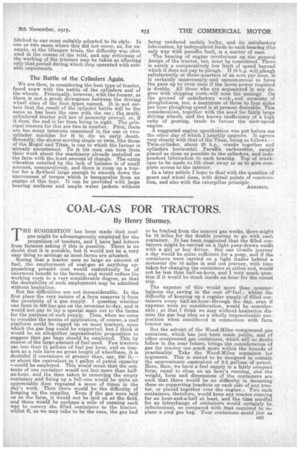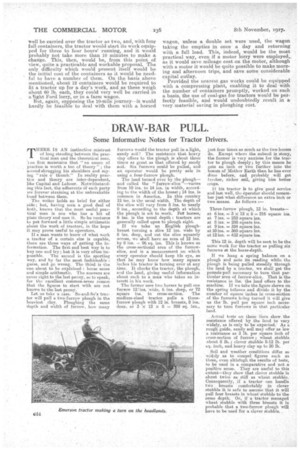COAL-GAS FOR TRACTORS.
Page 13

Page 14

If you've noticed an error in this article please click here to report it so we can fix it.
By Henry Sturmey.
THE SUGGESTION has been made that coalgas might be advantageously employed for the propulsion of tractors, and I have had letters from farmers asking if this is possible. There is no doubt that it is possible, but it would not be a very easy thing to arrange as most farms are situated.
Seeing that a tractor _uses so large an amount of fuel, the employment of coal-gas at anything approaching present cost would undoubtedly be of enormous benefit to the farmer, and would reduce his working costs to a very considerable degree, so that the desirability of such employment may be admitted without hesitation. .
But the difficulties are not inconsiderable. In the first place the very nature of a farm removes it from the proximity of a gas supply. I .question whether one farm in 500 has gas on the premises to-day, and it would not pay to lay a special main out to the farms for the purpose of such supply. Then, when we come to consider the means of application, of course, a roof platform could be rigged up on most tractors, upon which the gas bag could be supported, but I think it would be an altogether impracticable proposition to suggest that as bags should be employed.. This by reason of the large amount of fuel used. Few tractors use less than 21 gallons of fuel per hour, and as tractors as a rule have no great length of wheelbase, it is doubtful if containers of greater than, say, 250 ft.— or about the equivalent to 1 gallon of petrol capacity —could be employed. This would mean that the contents of one container would not last more than halfan-hour, and the time taken in removing the empty container and fixing up a full one would be quite an appreciable item repeated a score of times in the day's work. Then there would be the difficulty of keeping up the supplies. Even if the gas were laid on at the farm, it would not be laid on at the field, and there would be perhaps a mile of running each way to convey the filled containers to the tractor, whilst if, as we may take to be the case, the gas had to be fetched from the nearest gas works, there might be 10 miles for the double journey to go with each container. It has been suggested that the filled containers might be carried on a light pony-drawn outfit with a girl or boy driver. But one 10-mile journey a day would be quite sufficient for a pony, and if the containers were carried on a light trailer behind a motorcar the 10 miles in and out journey, with time taken for changing the containers at either end, would not be less than half-an-hour, and I very nmeh question if it would be much inside an hour for the round trip.
The expense of this would more than counterbalance the saving in the cost of fuel ; whilst the difficulty of keeping up a regular supply of filled containers every half-an-hourIthrough the day, even if expense were no consideration, would be considerable; so that I think we may without hesitation dismiss the gas bag idea as a wholly impracticable proposition when considered in connection with farm tractor use.
But the advent of the Wood-Milne compressed gas container, which has just been made public, and of other compressed gas containers, which will no doubt follow in the near future, brings the consideration of gas for tractor use much more within the bounds of practicality. Take the Wood-Milne container for argument. This is stated to be designed to contain the approximate equivalent of 2-3 gallons of petrol. Here, then, we have a fuel supply in a fairly compact form, equal to close on an hour's running, and the weight, form and dimensions of the containers are such that there would be no difficulty in Mounting them on supporting brackets on each side of any tractor, or placed together over the engine.. Two such containers, therefore, would keep any tractor running for an hour-and-a-half at least, and the time needful for an interchange of containers would certainly be infinitesimal, as compared with that required to replace a roof gas bag. Four containers could just as well be carried over the tractor as two, and, with four full containers, the tractor would start its work equipped for three to four hours' running, and it would probably not take more than 10 minutes to make a change. This, then, would be, from this point of view, quite a practicable and workable proposaL The only difficulty which would present itself would he the initial cost of the containers as it would he needful to have a number of them. On the. basis above mentioned, about 12 containers would be required to fit a tractor up for a day's work, and as these weigh about 60 lb. each, they could very well be carried in a tight Ford lorry, or in a farm wagon.
But, again, supposing the 10-mile journey—it would hardly be feasible to deal with them with a horsed wagon, unless a double set were used, the wagon taking the empties in once a day and returning with a full load. This, indeed, would be the most practical way, even if a motor lorry were employed,. as it would save mileage cost on the motor, although with a motor it would be quite possible to make morning and afternoon trips, and save some considerable capital outlay. Provided the nearest gas works could be equipped with a compressing plant, enabling it to deal with the number of containers promptly, worked on such a basis, the use of coal-gas for tractors would be perfectly feasible, and would undoubtedly result in a very•material saving in ploughing cult.






















